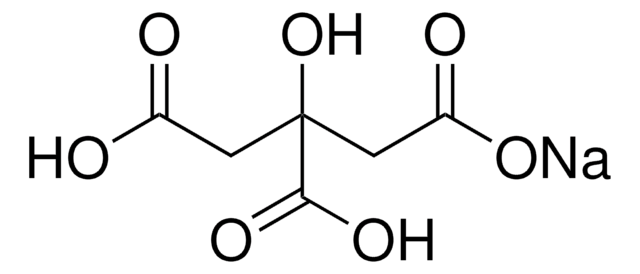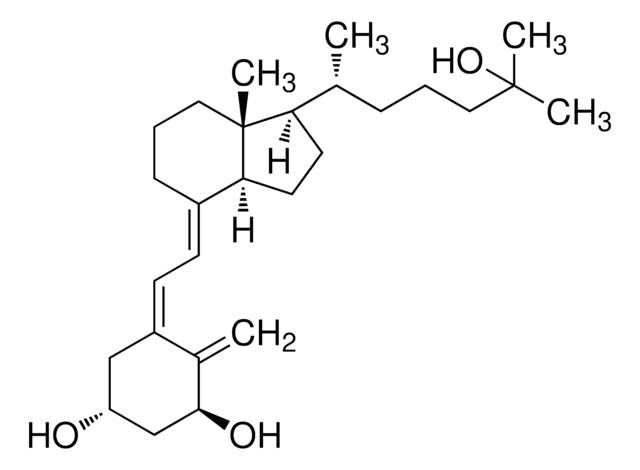C2806
Calcitonin Gene Related Peptide Fragment 8-37 human
≥97% (HPLC), powder
Sinónimos:
α-CGRP 8-37, FBHuman
About This Item
Productos recomendados
Quality Level
assay
≥97% (HPLC)
form
powder
composition
Peptide content, ~70%
storage temp.
−20°C
SMILES string
CC(C)C[C@H](NC(=O)CNC(=O)[C@H](C)NC(=O)[C@H](CC(C)C)NC(=O)[C@H](CCCNC(N)=N)NC(=O)[C@H](Cc1c[nH]cn1)NC(=O)[C@@H](NC(=O)[C@@H](N)C(C)C)[C@@H](C)O)C(=O)N[C@@H](CC(C)C)C(=O)N[C@@H](CO)C(=O)N[C@@H](CCCNC(N)=N)C(=O)N[C@@H](CO)C(=O)NCC(=O)NCC(=O)N[C@@H](C(C)C)C(=O)N[C@@H](C(C)C)C(=O)N[C@@H](CCCCN)C(=O)N[C@@H](CC(N)=O)C(=O)N[C@@H](CC(N)=O)C(=O)N[C@@H](Cc2ccccc2)C(=O)N[C@@H](C(C)C)C(=O)N3CCC[C@H]3C(=O)N[C@@H]([C@@H](C)O)C(=O)N[C@@H](CC(N)=O)C(=O)N[C@@H](C(C)C)C(=O)NCC(=O)N[C@@H](CO)C(=O)N[C@@H](CCCCN)C(=O)N[C@@H](C)C(=O)N[C@@H](Cc4ccccc4)C(N)=O
InChI
1S/C139H230N44O38/c1-66(2)48-86(161-102(193)60-155-113(197)74(17)159-120(204)87(49-67(3)4)168-118(202)83(40-31-45-152-138(147)148)163-123(207)90(53-80-57-151-65-158-80)173-136(220)111(77(20)188)182-131(215)105(145)69(7)8)121(205)169-88(50-68(5)6)122(206)176-96(64-186)129(213)165-84(41-32-46-153-139(149)150)119(203)175-94(62-184)115(199)156-58-101(192)154-59-104(195)177-107(71(11)12)134(218)179-108(72(13)14)133(217)166-82(39-28-30-44-141)117(201)171-91(54-98(142)189)125(209)172-92(55-99(143)190)124(208)170-89(52-79-36-25-22-26-37-79)126(210)180-109(73(15)16)137(221)183-47-33-42-97(183)130(214)181-110(76(19)187)135(219)174-93(56-100(144)191)127(211)178-106(70(9)10)132(216)157-61-103(194)162-95(63-185)128(212)164-81(38-27-29-43-140)116(200)160-75(18)114(198)167-85(112(146)196)51-78-34-23-21-24-35-78/h21-26,34-37,57,65-77,81-97,105-111,184-188H,27-33,38-56,58-64,140-141,145H2,1-20H3,(H2,142,189)(H2,143,190)(H2,144,191)(H2,146,196)(H,151,158)(H,154,192)(H,155,197)(H,156,199)(H,157,216)(H,159,204)(H,160,200)(H,161,193)(H,162,194)(H,163,207)(H,164,212)(H,165,213)(H,166,217)(H,167,198)(H,168,202)(H,169,205)(H,170,208)(H,171,201)(H,172,209)(H,173,220)(H,174,219)(H,175,203)(H,176,206)(H,177,195)(H,178,211)(H,179,218)(H,180,210)(H,181,214)(H,182,215)(H4,147,148,152)(H4,149,150,153)/t74-,75-,76+,77+,81-,82-,83-,84-,85-,86-,87-,88-,89-,90-,91-,92-,93-,94-,95-,96-,97-,105-,106-,107-,108-,109-,110-,111-/m0/s1
InChI key
NDACAFBDTQIYCQ-YVQXRMNASA-N
Gene Information
human ... CALCA(796)
¿Está buscando productos similares? Visita Guía de comparación de productos
Amino Acid Sequence
General description
Application
Biochem/physiol Actions
Calcitonin gene-related peptide (CALCA) serves as a proangiogenic growth factor in the development of human placenta. Mutations of CALCA gene is associated with Parkinson′s disease, ovarian cancer and essential hypertension. CALCA induce vascular endothelial cell proliferation, migration and capillary-like tube formation.
Other Notes
Storage Class
11 - Combustible Solids
wgk_germany
WGK 3
flash_point_f
Not applicable
flash_point_c
Not applicable
ppe
Eyeshields, Gloves, type N95 (US)
Certificados de análisis (COA)
Busque Certificados de análisis (COA) introduciendo el número de lote del producto. Los números de lote se encuentran en la etiqueta del producto después de las palabras «Lot» o «Batch»
¿Ya tiene este producto?
Encuentre la documentación para los productos que ha comprado recientemente en la Biblioteca de documentos.
Los clientes también vieron
Nuestro equipo de científicos tiene experiencia en todas las áreas de investigación: Ciencias de la vida, Ciencia de los materiales, Síntesis química, Cromatografía, Analítica y muchas otras.
Póngase en contacto con el Servicio técnico










